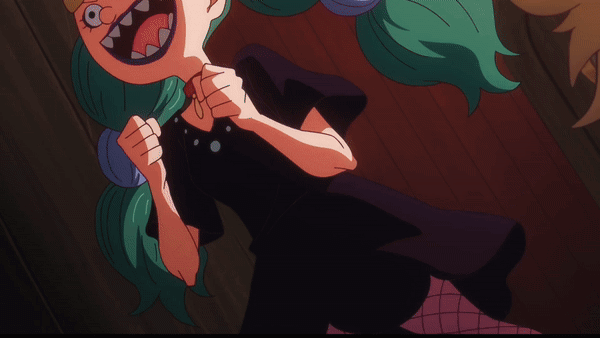Dive NicEustass
Calennig "Dive" NicEustass
In late December 1518, on the seas of the South Blue around the Mouth of the Grand Line, Killer would give birth to a tiny premature baby girl. Too small, too weak, the baby struggled to breathe and would not eat, and passed away after only a few hours.
Killer would lock herself away in the still in-progress nursery with the tiny girl for days, leaving the crew struggling to decide what to do. By the time they decided to try and replace the corpse with a doll until they could get her to professional help, Killer would come out on her own with a strange looking and very much alive baby suckling her.
The infant was a queer little thing - almost human but teeth too sharp, eyes too smart. Each time it nursed, it drew blood - seeming just as happy with that as it was with the milk, and Killer's physical health was clearly at risk but she was also starting to mentally come around for the first time after giving birth. She refused to let the crew that the baby from her, and in the end, they agreed to let her keep it as long as they got Killer eating better and she got stronger. They looped the South Blue in the mean time, needing her at the top of her game before they attempted the Grand Line, delaying their voyage for the next year
And so did the baby. The creature grew fast - much more than any human baby would - at almost twice the rate, and little Dive - as she'd come to be nicknamed after she took to the water with such an ease, swimming far stronger than she walked - looked almost four once the crew finally passed though Reverse Mountain, despite only a year and a half delay after she arrived on the Victoria Punk-go.
No one is really sure what Dive is - just some kind of changeling. They try to keep this from her; Kidd already had declared Killer's child was his regardless of parentage, and he holds fast to this even after that original child was replaced. Once Dive started to piece things together at just how different she is, Kidd sits down and reassures her that the Punk is her home, the Kidd Pirates are her family, and she will always be Kidd's kid - if that's what she wants. That he's always known that there was no blood to tie them together, but she was his the moment Killer introduced them.
When she's older, she asks him about the baby she replaced - if he ever resented her for that? She's afraid to ask Killer, afraid the woman who nursed her might secretly hate her, and Kidd tells her then that Killer's baby had already died. The way he's come to see it, is the sea gave his family a gift; the South Blue herself saw a mother who'd lost her child and gave her a child who needed a mother.
Physical Description
General Physical Condition
Dive is a relatively short woman sporting lipstick and large braided pigtails. She wears round sunglasses over her forehead, a ragged shirt, a necklace and a pair of stockings coupled with high heels.
https://onepiece.fandom.com/wiki/Dive
References
- In Scottish Gaelic tradition, the changeling was called tàcharan or umaidh. In Irish folklore, it was corpán sidhe, síodhbradh or síofra; and in Manx it was Ihianoo shee. The Welsh called them plentyn a neidiwyd am arall.
- tàcharan m (genitive singular tàcharain, plural tàcharanan) (Noun)
- changeling
- (dated) orphan
- (dated) weak, helpless, cowardly, feeble person
- (obsolete) yelling of ghosts
- In Irish legend, a fairy child may appear sickly and will not grow in size like a normal child, and may have notable physical characteristics such as a beard or long teeth. They may also display intelligence far beyond their apparent years and possess uncanny insight. A common way that a changeling could identify itself is through displaying unusual behaviour when it thinks it is alone, such as jumping about, dancing or playing an instrument – though this last example is found only within Irish and Scottish legend. - Mac Philib, Séamas (1991). "The Changeling (ML 5058) Irish Versions of a Migratory Legend in Their International Context". Béaloideas. 59: 121–131. doi:10.2307/20522381. JSTOR 20522381.
- Other folklore says that human milk is necessary for fairy children to survive. In these cases, the newborn human child would be switched with a fairy baby to be suckled by the human mother. - Briggs (1979)
- In Wales, the changeling child (plentyn newid (sing.), plant newid (pl.)) initially resembles the human child for which it has been substituted, but gradually grows uglier in appearance and behaviour: ill-featured, malformed, ill-tempered, given to screaming and biting. It may be of less than usual intelligence but may equally well be identifiable because of its more-than-childlike wisdom and cunning. - Wirt Sikes. British Goblins: The Realm of Faerie. Felinfach: Llanerch, 1991.
- https://en.wikipedia.org/wiki/Changeling
.jpg)
https://www.hellominju.com/2024/06/ONEPIECE1109.html
Naming References:
- Calennig ([kaˈlɛnɪɡ]) is a Welsh word meaning "New Year celebration/gift", although it literally translates to "the first day of the month", deriving from the Latin word kalends. The English word "calendar" also has its root in this word. - https://en.wikipedia.org/wiki/Calennig
- It is a tradition where children carry a decorated apple, pierced with three sticks and decorated with a sprig of box and hazelnuts on New Year's Day. Children would sing a verse and were often gifted with money or food. - "New Year Traditions: Collecting Calennig". Museum Wales. Retrieved 2 October 2022.

Currently Boarded Vehicle
Species
Date of Birth
december 31
Year of Birth
1518 Kaienreki
Family
Children
Aligned Organization
Related Myths
Related Plots
.jpg)



Comments